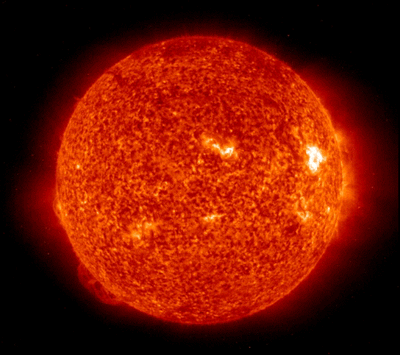
Ever since I renewed my interest in HF radio communications, I researched the Sun with equal fervor because this celestial body affects Amateur Radio in ways only a few truly understand. Wikipedia defines the Sun as: the star at the center of the Solar System. It is almost perfectly spherical and consists of hot plasma interwoven with magnetic fields.
This massive body is composed mostly of hydrogen and helium, is 150 million kilometers from our planet, is 4.5 billion years old and is about at the half way point of its life. My curiosity revolves around the Sun’s magnetic field which is the phenomenon behind every Amateur Radio fields of interests and daily discussions: dark spots, magnetic storm, radio blackouts, propagation. We’ve all heard “The propagation isn’t good today” and hopefully, this article can shine a bit of light on the reasons why.
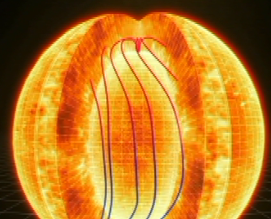
SOLAR MINIMUM
This scale and mass , and the fact that the equator region of the sun spins much faster than it’s pole, produces a distortion of its magnetic fields. The cycle during which these distortions occur are called solar minimum and the solar maximum.
Amateurs Radio operators often refer to this a the 11 years cycle, where it takes approximately 11 years for the Sun to start with stable fields (Solar minimum), begin slowly distorting by the Sun’s rotation and when they reach their maximum distortions (Solar maximum), the Sun reverses the polarity of its poles and we have a stable fields again (Solar minimum). While the Sun distorts its field, several phenomenon appears on its surface and around its corona. The first phenomenon are called sun spots.
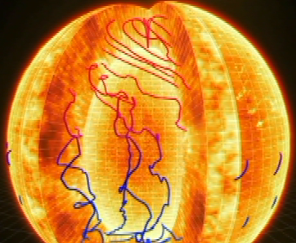
SOLAR MAXIMUM
These sun spots are the results or the Sun’s surface being cooler than its surroundings The magnetic fields beneath the spot are so strong that heated plasma originating from the core is blocked and deviated from that region of the sun.
The spots aren’t actually dark, we just see them that way because the wavelength captured by the optical instruments are tuned to certain temperature. Colder temperature appear darker. If we change the wavelength of the instrument, the spots will become bright again. Sun spots aren’t influencing radio signal propagation back on earth, magnetic fields generating the sun spots are. The spots are often the first stage of solar maximum. The number of solar spots can dwindle down to zero during solar minimum and a few hundreds during solar maximum.
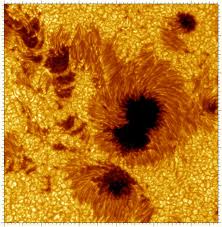
Counting >150 spots can entice some very interesting propagation conditions on HF radio. I’ve heard from experienced Amateur operators that in the early 50′s, the numerous sun spots (+250) was such that amateurs were able to establish DX contacts clear across the globe with 1 watt of power and the most basic of HF antenna. Suns spots at that time were also the biggest ever recored, reaching up to 40 times the size of our Earth.
Another phenomenon created by magnetic field line distortion are corona field storms. These are not flares yet! These are essentially magnetic fields greatly distorted and so strong that they literally poke out of the Sun surface, producing elegant arcs of plasma that can reach out hundreds of thousand of kilometres over the sun’s surface. In general, we can’t see a magnetic field, but these ones are visible because of the Sun’s plasma is being dragged along the fields and light up the corona.
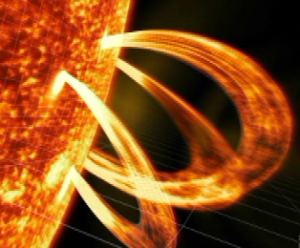
These magnetic field lines indicate brewing magnetic activities within the sun that can be called the second stage of solar maximum. This increasing activities in the Sun magnetism is directly responsible for affecting our ionosphere layers, and affect how well HF frequencies propagates. I will discuss that subject in greater details in a future review.
While the sun’s rotation distorts these magnetic field lines and they in return manage to escape the sun’s surface, a new phenomenon is taking place called magnetic sail effect, which is similar to a sailing boat’s sail flapping in the wind. Eventually, if the number of sails (Or field lines) is sufficient and they happen close to one another, that’s when the most violent events occur.

When two or more strong magnetic field lines cross, there are extremely violent explosions called solar flares, also referred to as CME (Corona Mass Ejection). The resulting explosions are strong enough to catapult portions of the field lines into space, along with it’s plasma content and generates vast quantities of XRay. When these flares happen and the CME resulting is directed at us, that’s when we have to worry as these clouds of solar material are being hurled toward us, our technology based modern society could gamble all its chips and loose.
In about 8 seconds, large quantities of X-Ray hit our ionosphere sometimes producing instant radio blackouts and this is only the prelude to what is about to happen. The CME has been ejected at anywhere between 1 million and 5 million kilometers and hours and this wave of plasma and charged particles will reach us in a few hours or a few day, depending how strong the CME explosion was. From that moment, space weather specialists have to predict if this solar flares will hit us with devastating force, or just a a mild storm. It’s exactly like predicting the weather here on earth. There is a certain degree of uncertain probability governing their predictions.
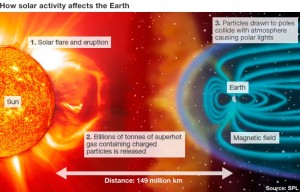
Solar weather specialist have very little time following a solar flare to determine where its going to hit and what is the polarity of the storm. In fact, they have to predict if the portion of the storm hitting us has a similar or reverse polarity with our planet’s magnetic field. If the portion of the storm that hits our north pole is positively charged, and our north pole is also positively charges, the storm will be repulsed by our planet’s magnetic field, acting as shield.
On the other hand, if the polarity are inverted, the storm and our magnetic field will be attracted to one another, the storm will penetrate our poles and discharge it’s energy in our ionosphere, producing beautiful Aurora, unfortunate radio blackouts, potential satellite and electronic failure and sometimes, power blackouts. In a nutshell, that’s how solar storms are created and how they can affect us. There are historical accounts dating back to the mid 1700′s which describe massive solar storms producing Aurora visible anywhere on the planet. If the strength of such a storm would happen today, some say it would throw our modern society back to the stone age in a hurry and could take a decade to repair the damages made to our electrical grids. If this day ever happens, be prepared to chop wood and shoot squirrels for a little while.
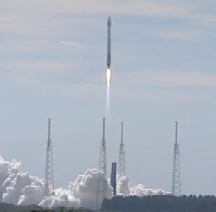
These Solar events have been observed for centuries. Drawings and sketches of solar events have been around for over 500 years. But just recently did we put into place instruments that will let us understand the inner-workings of our Sun. Nasa’s Solar Dynamic Observatory satellites launched in February of 2010 is our around the clock surveillance of the Sun, something we were not able to do until today.
The extreme high-resolution instruments on board the SDO satellite are so sophisticated, they greatly surpass our ability to observe the Sun from our Earth using telescopes. SDO’s instruments allow us to look at our sun with different wave length, putting into contrast all the hidden features of this star and that’s the key into understand solar mechanics and possibly predicting solar weather.
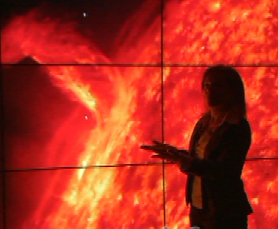
The effects of solar weather on Amateur Radio is much greater than I originally imagined. When I first started this hobby, I kept hearing about sun spots and how their numbers would positively or negatively affect this hobby. I just had to dig a little more to find out how these sun spots were created, and while doing so, I stumbled into a world of space science I can only begin to enjoy and explore.
Fortunately for us, the SDO satellite generates images with such vividness and resolutions that we are front row centre to the greatest light show imaginable. They will help solar specialists better understand solar mechanics and hopefully help us better prepare for the perfect solar storm.
73′s.
VE2XIP
Fun facts about our sun:
Equatorial Radius: 695,500 km
Equatorial Circumference: 4,379,000 km
Volume: 1,142,200,000,000,000,000 km3
Mass: 1,989,000,000,000,000,000,000,000,000,000 kg
Density: 1.409 g/cm3
Surface Area: 6,087,799,000,000 km2Surface Gravity: 28 G Equatorial or 274.0 m/s2
Rotation: pole = 35 days, equator = 25 days
Velocity Relative to Near Stars: 19.7 km/sEscape Velocity: 2,223,720 km/h
The Sun makes up around 99.86% of the Solar System’s mass.
It’s 1,392,000 kilometres (865,000 miles) wide.
The Sun’s diameter is about 110 times wider than Earth’s.
Light from the Sun reaches Earth in around 8 minutes.
The Sun’s surface temperature is around 5500 degrees Celsius (9941 degrees Fahrenheit).
The Sun’s core is around 13,600,000 degrees Celsius.
